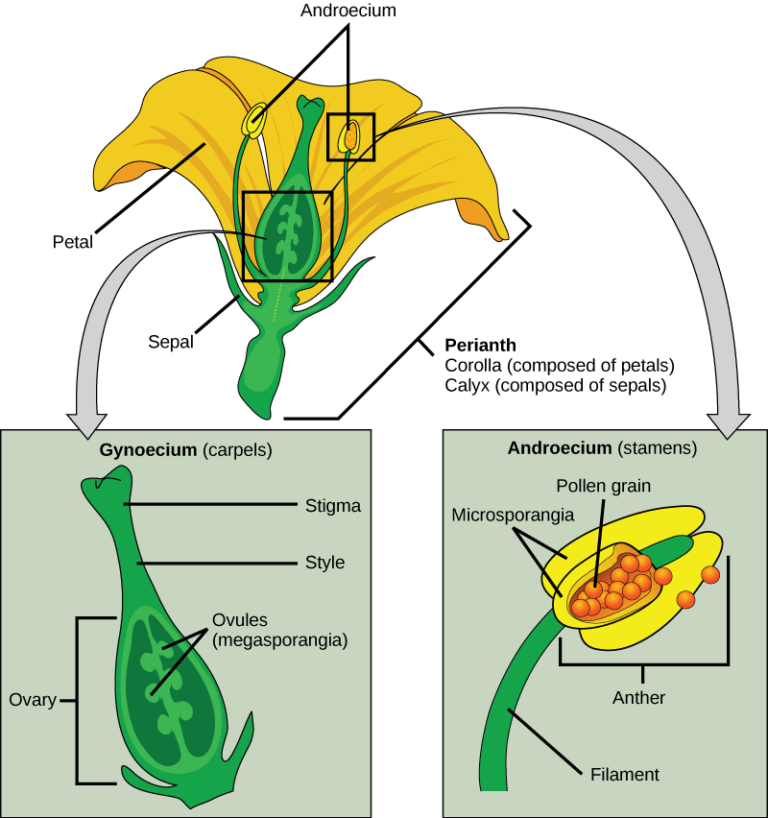Comprehensive Guide on Reproduction in Flowering Plants for Class 12 pdf Download
Introduction in Flowering Plants Class 12 Notes
Reproduction in flowering plants is a fundamental topic in the Class 12 biology curriculum. Understanding the intricacies of this process is crucial for students as it forms the basis for various biological concepts.
This guide provides detailed notes on the reproduction mechanisms in flowering plants, covering essential topics such as flower structure, pollination, fertilization, seed formation, and more.
Structure of a Flower
- Sepals (Calyx): These are the outermost whorl of the flower, typically green and leaf-like, protecting the developing bud.
- Petals (Corolla): Often colorful and fragrant, petals attract pollinators.
- Stamens (Androecium): The male reproductive organs consisting of anthers and filaments. Anthers produce pollen grains.
- Carpels (Gynoecium): The female reproductive organs comprising the ovary, style, and stigma. The ovary contains ovules.
Pollination
Pollination is the transfer of pollen from an anther to a stigma. It can occur through various mechanisms:
Self-Pollination (Autogamy): Pollen from the anther is transferred to the stigma of the same flower or another flower on the same plant.
- Cross-Pollination (Allogamy): Pollen is transferred from the anther of one flower to the stigma of another flower on a different plant of the same species. Agents of cross-pollination include:
- Wind (Anemophily)
- Water (Hydrophily)
- Insects (Entomophily)
- Birds (Ornithophily)
Fertilization
Pollen Germination: Upon landing on a compatible stigma, the pollen grain germinates, forming a pollen tube that grows through the style to reach the ovary.
Double Fertilization: A unique feature of angiosperms where one sperm nucleus fertilizes the egg cell forming a zygote, and the other fuses with two polar nuclei to form the triploid endosperm, which nourishes the developing embryo.
Seed Formation and Development
Embryogenesis: The zygote undergoes mitotic divisions to form an embryo.
Seed Coat Formation: The integuments of the ovule develop into a protective seed coat.
Endosperm Development: The triploid endosperm forms, providing nutrients to the growing embryo.
Seed Maturation: The seed dehydrates and enters a period of dormancy until conditions are favorable for germination.
Fruit Formation
Post-fertilization, the ovary develops into a fruit, which protects the seeds and aids in their dispersal. Fruits can be:
Fleshy: Such as apples and tomatoes, where the pericarp (ovary wall) becomes thick and juicy.
Dry: Such as beans and nuts, where the pericarp dries out at maturity.
Seed Dispersal
To avoid competition and promote species spread, seeds are dispersed through various mechanisms:
- Wind (Anemochory)
- Water (Hydrochory)
- Animals (Zoochory)
- Self-Mechanisms (Autochory)
Conclusion
Reproduction in flowering plants is a complex and fascinating process essential for the continuation of plant species. By understanding the detailed mechanisms involved in flower structure, pollination, fertilization, seed formation, and dispersal, students can appreciate the intricate balance of nature that ensures plant diversity and survival.
Download the Comprehensive PDF Notes
To aid your study and revision, download the detailed Class 12 notes on “Reproduction in Flowering Plants” in PDF format.
Click Below To Download Reproduction in Flowering Plants Class 12 Notes pdf
References
- NCERT Biology Textbook for Class 12
- Campbell, N.A., Reece, J.B. (2011). “Biology.” Pearson Education
- Taiz, L., Zeiger, E. (2010). “Plant Physiology.” Sinauer Associates
By mastering these concepts, students will be well-prepared for their examinations and future studies in biology.




